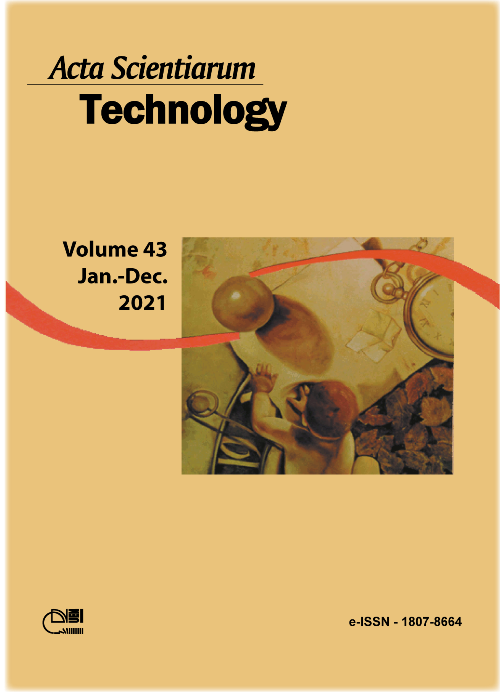Characterization of Nopalea cochenillifera clones using linear dimensions and multivariate analysis
DOI:
https://doi.org/10.4025/actascitechnol.v43i1.50257Palavras-chave:
little sweet clone; giant sweet clone; morphometric characteristics.Resumo
Forage cacti can contribute to increases in biomass yields in agricultural areas, improving the use efficiency of local natural resources. Forage cactus stands out as a forage alternative in semi-arid regions due to its high potential of phytomass production and energy value, large water reserve and easy propagation. The objective of this study was discriminate as morphometric characteristics of Nopalea cochenillifera cladodes in relation to Little and Giant Sweet clones. This research was conducted from March 2016 to July 2019. The design used was randomized blocks with five replicates using the forage cactus clones Little and Giant Sweet of Nopalea cochenillifera (L.) Salm-Dyck. The experimental unit was an area of 126.0 m2 (12.6 x 10.0 m). Study sample is composed of 1018 cladodes (581 of Little Sweet clone) and (437 of Giant Sweet clone), randomly collected. Variables evaluated were the cladode length, width, thickness, area weight. T-tests, Pearson correlation coefficients, discriminant analysis and canonical variables analysis were used to evaluate, compare and discriminate the morphometric characteristics of forage cactus clones. The Giant Sweet clone presented the highest means for the variables length, width, area and weight. Fisher's discriminant function verified a 99.41% hit rate to differentiate groups of forage cactus clone. The hit rate for Little Sweet clone was of 98.97%, while for Giant Sweet clone was of 100.00%. With two canonical variables the explanation rate of the morphometric characteristics for the behavior of forage cactus clones is higher than 90%. Morphometric characteristics of cladodes can be used as parameters that help in the identification of Nopalea cochenillifera clones with high discriminatory power.
Downloads
Downloads
Publicado
Como Citar
Edição
Seção
Licença
DECLARAÇíO DE ORIGINALIDADE E DIREITOS AUTORAIS
Declaro que o presente artigo é original, não tendo sido submetido í publicação em qualquer outro periódico nacional ou internacional, quer seja em parte ou em sua totalidade.
Os direitos autorais pertencem exclusivamente aos autores. Os direitos de licenciamento utilizados pelo periódico é a licença Creative Commons Attribution 4.0 (CC BY 4.0): são permitidos o compartilhamento (cópia e distribuição do material em qualqer meio ou formato) e adaptação (remix, transformação e criação de material a partir do conteúdo assim licenciado para quaisquer fins, inclusive comerciais.
Recomenda-se a leitura desse link para maiores informações sobre o tema: fornecimento de créditos e referências de forma correta, entre outros detalhes cruciais para uso adequado do material licenciado.



















